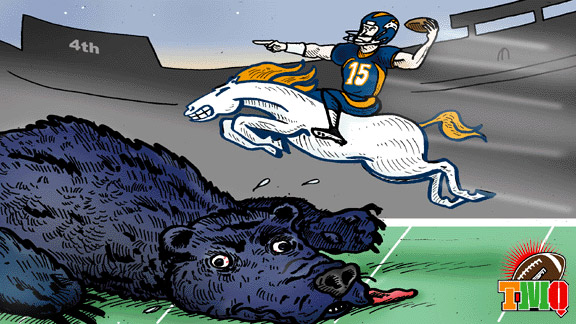
Denver, Tebow wearing teams down
God, at 6:48 p.m. ET on Sunday: "Can you cherubim and seraphim hold it down over there? I'm trying to watch the Broncos game."
The New York Giants looked finished when they took possession with 5:41 remaining on the road at Dallas, trailing by 12. But never underestimate the ability of the Dallas Cowboys to display low football IQ! Last week, Boys coach Jason Garrett cost his team a game by icing his own kicker. This week Dallas shifted to a two-man rush on the final Jersey/A drive, giving Eli Manning ample time to scan the field. Dallas showed the infamous prevent defense, which prevents only punts. Texas is the center of football culture: Why is the Cowboys' football IQ so low? After nonstop boasting by Rob Ryan, the 'Boys defense allowed 510 yards at home. Ye gods.
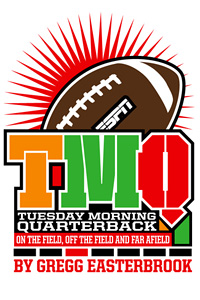
And the Denver Broncos looked really, really finished when they took possession with 4:34 remaining in regulation, trailing by 10. Denver hadn't scored in the game. Tim Tebow had misfired on 11 consecutive forward-pass attempts. Despite having the league's No. 1 rushing offense, Denver coaches ordered punts on fourth-and-1, fourth-and-1 and fourth-and-2.
But look up into the stands -- nobody has left the stadium. The sellout crowd sensed yet another Tebow comeback. Seven consecutive completions for a quick touchdown made it 10-7 near the two-minute warning, after the Chicago Bears switched to a very soft prevent look. Chicago recovered the onside kick and again Denver, out of timeouts, appeared finished. Then Bears tailback Marion Barber casually ran out of bounds, stopping the clock. Perhaps they don't teach football IQ in Illinois, either. Denver gets the ball back, three more quick completions, and the Broncos can't seriously tie the game on a 59-yard field goal on the final snap! The Bears fumble in overtime, and the Broncos can't seriously hit two consecutive 50-yard-plus, do-or-die field goals!
Obviously one aspect of the string of Denver fourth-quarter comebacks is that Tebow is a special player. Equally important, since football is a team sport, is that other members of the Broncos squad are performing well. But there is a football-tactics aspect, too.
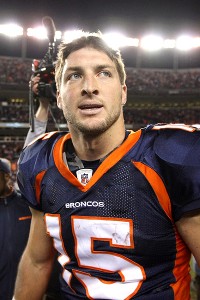
Denver has become the NFL's top rushing team, and the running game often starts slowly. In the first half the defense is fresh, and may stop the run. By the fourth quarter, the front seven is tired and becomes vulnerable. Denver is hammering opponents with rush after rush in the early part of the game, and seeming not to accomplish much. Then the Broncos switch to attack mode in the fourth quarter, when the defense is tired.
Denver's use of the high-school-style zone-read option also forces defenses to defend all 11 Broncos players on rushing downs. Usually in the NFL, on a rush down the defense defends only 10 players. Against the Broncos, all 11 offensive players must be defended. By the fourth quarter, defenders are more winded than they would be against a standard offense. Tebow carried 12 times versus Chicago, and there were many other downs on which he ran out zone-read fakes, forcing the defense to account for him. That's a lot of snaps on which the Bears' defense had a more tiring task than it would have had against most of the NFL's teams. By late in the fourth quarter, Chicago's defenders were visibly sucking air -- the high altitude didn't help either. On Denver's touchdown drive that began with 4:34, the Bears' defensive line got no push -- merely brushed the offensive line, then stood there watching Tebow.
So it's not just craziness in these Denver comebacks, though craziness surely is a big factor in the entertainment value. It's tactics. Denver is using tactics that are likely to result in an explosion of yardage late in the game. Opponents need to realize this, and "roll" their defenses -- bringing personnel out to rest -- from the first quarter on.
In other sports news, right now big-time collegiate athletics couldn't look worse: scandals at Ohio State, the University of Miami and elsewhere, plus allegations of crime in the football facility at Penn State. The law-abiding part of collegiate athletics doesn't look so great, either. The NCAA recently announced what it billed as a major initiative to put the student back in student-athlete. What's the bold, visionary goal? That 50 percent of Division I football and men's basketball players graduate. And the rule doesn't take effect for five years!
Worst is the continuing institutional outrage of big-college football and basketball programs using up African-American players and throwing them away. Last year's BCS title team, Auburn, graduates only 52 percent of its African-American players. The previous year's title team, Alabama, graduates 62 percent. The current NCAA men's basketball champion, Connecticut, graduates 14 percent of its black players, a figure that is horrendous regardless of early departure for the pros. (Find any Division I college's graduation rates here; choose "FGR" for the ethnic breakdown.)
Yet despite all the problems, big-deal sports is great for college! Genuine reform is needed, and is systematically avoided by the NCAA, the conferences and most university presidents. But even taking into account the avoidance of genuine reform, sports is still good for college.
Sports mania is among the reasons nearly all the top colleges and universities are in the United States -- though Europe started building universities centuries before America did. In my 2009 book "Sonic Boom," I listed the world's elite colleges and universities. Eighty-nine are in the United States, 11 in the rest of the world combined. The book says, "Technology, science, military power, movies, resources, space exploration, traffic jams -- the United States leads in many arenas. But in no arena is the U.S. lead as high as 10:1, roughly the American advantage, compared to the rest of the world, in first-quality colleges." Ben Wildavsky, author of "The Great Brain Race," a book devoted to educational globalization, seconded that view recently in Foreign Policy.

Why has sports mania helped American higher education? By raising enthusiasm about college. Big-deal football and basketball cause colleges to be seen by young people as exciting institutions to attend. Sports provide pizzazz to the life of a campus -- much more than do music and theater, though they also are important to the campus experience. Sports events make state legislatures want to fund colleges, make donors want to give to schools, make alumni want to stay in touch. Sports puts the names of colleges in newspapers daily.
The enthusiasm generated by sports events on campus surely is one reason 50 percent of American 18- and 19-year-olds are enrolled in college. And that excitement need not stem from a top-25 football game. Check this photograph from Pittsburg State University of Kansas. Even low-cost, small-scale athletics can generate campus animation.
Consider the comparison to the European Union, where colleges generally do not have team sports. In Europe, most athletic events either are professional, or oriented around clubs that operate independent of educational institutions. European universities are seen as preserves of learning, and nothing more. Maybe that view is philosophically correct, but inevitability limits general enthusiasm for college. In Europe, fewer students attend compared to the United States. Private donations to universities are rare. And adults sure don't walk down the street wearing Imperial College hoodies or SciencesPo baseball caps, the way large numbers of adults wear college-loyalty apparel in the United States.
According to this 2010 study by the College Board, 40 percent of American citizens hold at least an associate degree, compared to 32 percent of citizens of the United Kingdom -- the nation most similar to the United States. Broadly across the European Union, college achievement is lower than in the United States. Some 32 percent of Danes hold at least an associate degree, 27 percent of French citizens and 24 percent of German citizens.
American success with spreading higher education to huge numbers of people -- to "the masses," as a European might say -- is especially striking when one bears in mind that college almost always costs more in the United States than in the European Union. Yet very large numbers of Americans are inspired to attend. The campus excitement generated by sports is among the reasons.
Consider a simple thought experiment: If American universities abolished sports, would the higher education be better off? Alumni support for most colleges would decline; enrollments almost surely would decline; public interest in colleges would decline. Swarthmore can be an extremely successful college that inspires admissions lust without having a football team, but how many colleges are Swarthmore? For most colleges and universities, loss of sports would be a major step in the wrong direction.
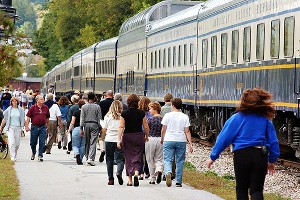
The many faults of the collegiate athletic scene are not new, and existed during the same period American universities and colleges expanded dramatically in attendance and quality. In 1905, the University of Wisconsin faculty declared its desire to end the football program, stating, "Football has become a business supported by levies on the public." A 1929 Carnegie Foundation report characterized college sports as out of control and declaimed "the costly varsity sweaters and extensive journeys in special Pullman cars." In 1939, the University of Chicago ended its football program, president Robert Hutchins saying football "has the same relationship to education as bullfighting has to agriculture." An attempted 1940s college sports reform actually was called the Sanity Code (it failed). In 1961, the Ohio State University faculty voted not to accept a Rose Bowl invitation, feeling an athletic scandal had tarnished the school. Many more such examples can be found in the invaluable new book "Pay for Play," a history of financial and academic shenanigans in collegiate athletics, by Penn State historian Ronald Smith.
Yet though scandals have plagued college athletics for a century -- and faculty control of athletics has nearly vanished, replaced by quasi-independent athletic departments run like businesses stamped with the college brand -- in the same period, American higher education has expanded in an historically unprecedented way. Sports mania helped. Collegiate athletics need genuine reform, not the sort of sweep-under-the-rug changes that the NCAA specializes in. But sports themselves, and American colleges, were made for each other. College life should reflect society, and American society is sports-mad. It's who we are!
And in other NFL news, by the third quarter at Green Bay, the Packers led Oakland 43-7. That means if the game had been played under National Federation of High Schools rules, the timekeeper would have switched to "running clock" in which the clock almost never stops, shortening the contest. The running clock, used when the margin is 35 points or more, is the most common mercy rule found in high school football. The Packers reached it in the third quarter!
Stats of the Week No. 1: Against Chicago, Tim Tebow was 3-for-16 for 45 yards in the first three quarters, 18-for-24 for 191 yards after that.
Stats of the Week No. 2: Houston has won seven straight; the Buccaneers have lost seven straight.
Stats of the Week No. 3: Green Bay's 57 touchdowns are more than twice the total touchdowns of 10 NFL teams (San Francisco, Miami, Seattle, Tampa, Washington, Indianapolis, Jacksonville, Cleveland, Kansas City and St. Louis).
Stats of the Week No. 4: In the first half at Jersey/B, the Chiefs gained four offensive yards.
Stats of the Week No. 5: Final score of the past four Tennessee Titans games: 23-17, 23-17, 23-17 and 22-17. Noted by reader Jon Meindersma of West Boylston, Mass.
Stats of the Week No. 6: Born in Ohio, Ben Roethlisberger is 13-1 as a starter versus the Cleveland Browns.
Stats of the Week No. 7: Buffalo and San Diego opened the season a combined 8-2 and since have gone a combined 3-13.
Stats of the Week No. 8: The last time the Indianapolis Colts held a lead was on Oct. 9.
Stats of the Week No. 9: The Bears went six consecutive quarters without a third-down conversion.
Stats of the Week No. 10: Defending champion Green Bay not only has won 19 straight games, the Packers have not trailed in the fourth quarter for 19 straight games.

Cheerleader of the Week: Reader Liam Bradley of Huntington Beach, Calif., writes, "We Colts fans don't have much going for us this season. We should be able to win something, so I nominate Lauren M. of the Colts as cheerleader of the week." According to her team bio, Lauren's favorite childhood memory is "being stepped over by an elephant in Asia." Bradley notes, "She says her favorite quote is about dreams coming true, hopefully that means Andrew Luck coming our way." Assuming Indianapolis gets the first selection of the draft, what makes everyone so sure the Colts will choose Luck?
Sweet Play of the Week: Carolina opened sweet against favored Atlanta. Reaching first-and-goal at the Falcons' 6, the Panthers lined up empty, with tall tight end Jeremy Shockey in a slot position. Cam Newton started a quarterback draw, and stopped, leapt into the air and threw to the uncovered Shockey for six. Later, DeAngelo Williams took a textbook toss 74 yards to the house behind a perfect pull block by undrafted tackle Byron Bell.
Then it was Atlanta's turn. Trailing 23-10, the Falcons had second-and-6 on the Carolina 31. Matt Ryan executed a perfect "show" fake, holding the ball out as if to hand off to 5-6 tailback Jacquizz Rodgers, and making sure the defense saw the ball. Then Ryan rolled right as if to bootleg; a tight end had gone into the right flat, as if he were the primary receiver. Rodgers ran a "wheel" route out of the backfield up the left sideline, covered by a linebacker. Ryan made the difficult back-across-his-body throw, touchdown. Atlanta went on to win, probably because of Ron Rivera's ski apparel -- see below.
Sour Redskins Plays of the Week: "He held the ball too long." That's what every TV commentator said of quarterback Rex Grossman, who was sacked in the end zone for a safety by former teammate Andre Carter in the New England at Washington collision. Time the play -- Grossman was starting his throwing motion at three seconds. The problem was not that he held the ball too long. The problem was that undrafted free agent emergency left tackle Willie Smith, filling in for the megabucks Trent Williams (suspended for failing drug tests), did an "olé" block, all but stepping out of Carter's way. If the offensive line can't give the quarterback three seconds, don't blame the quarterback. And don't blame the undrafted emergency left tackle. Blame Williams, who took $11 million from the Skins for this season, then seriously messed up.
New England tight end Rob Gronkowski came into the game with 13 touchdown receptions, close to the record for his position. So you'd think the defense would have paid some attention to him. You'd think wrong.
Flying Elvii on the Skins 11 in the first quarter, Washington lined up in the rare Cover Zero -- no high safety -- for yet another of the all-out blitzes that have consistently backfired on the Redskins in the past two seasons. Across from the huge Gronkowski was the inexperienced, 5-foot-11 DaJon Gomes. Gronkowski did a quick "swim" move on the befuddled Gomes for an easy-looking touchdown reception.
Later, score tied in the third quarter, New England faced third-and-12 on the Washington 37. You don't need a sack here -- the Patriots are already out of field-goal range. Nevertheless, Washington big-blitzed. Gronkowski ended up covered by linebacker Ryan Kerrigan, catching another easy-looking touchdown catch to set the single-season record for touchdowns by a tight end. Just to prove this was no fluke, on the play, Washington corners Josh Wilson and DeAngelo Hall just stood there watching Gronkowski run the final 10 yards to pay dirt.
Later, Wilson intercepted Tom Brady in the end zone. He celebrated wildly, doing a Lambeau Leap into the stands. Not only had Wilson not scored a touchdown -- the Redskins were trailing at the time.
Sweet 'N' Sour Playoff-Clinching Plays of the Week: The Houston Texans had never made the playoffs. Trailing Cincinnati 19-13 with 18 seconds on the clock, out of timeouts, third-string quarterback T.J. Yates at the controls, Houston faced third-and-10 on the Bengals 23. Incompletion. But Cincinnati corner Adam Jones, who grabbed a receiver during his route, did a theatrical hands-in-the-air gesture, meaning "I didn't commit a penalty." Then the flag flew -- Jones talked the officials into penalizing him! As TMQ points out, football players should never make the hands-in-the-air "I didn't do it" gesture. This only notifies the zebras you did, in fact, do it. Always act nonchalant! Very sour.
Now the Texans have second-and-goal on the Cincinnati 6, eight ticks showing. Houston lines up empty with two wide receivers on each side and a tight end right; twice-waived Kevin Walter is farthest outside on the right. On that side, the tight end and slot man run "drive" routes to the right of the end zone, dragging defensive backs with them. Walter hesitates, then simply cuts underneath. Backup linebacker Brandon Johnson moves to guard Walter, but falls down; touchdown. An uncovered receiver scoring as the clock expires to put Houston into the postseason for the first time: sweet. Cincinnati had six defensive backs on the field, yet none even tried to cover the opposition's possession receiver: sour.

TMQ's Christmas List: I am hoping to find an Mforcer marshmallow launcher in my stocking. As reader Luke Ormand of Patchogue, N.Y., notes, the disclaimer warns, "Do not shoot into mouth … do not eat marshmallows after shooting."
Last week's Christmas list included an "authentic replica" of Harry Potter's wand -- an "authentic" replica of something that does not exist. Why not get that certain someone on your list some "genuine faux pearls"? We guarantee they are fake -- accept no substitutes!
Bowl-a-Rama: This year there are 35 Division I bowls. That means 35 of the 120 Division I football programs -- 29 percent -- end their years on a high note with a nationally televised postseason victory. In the Darwinian world of the NFL, one of 32 teams -- 3 percent -- ends its year with a postseason victory.
Here are the major bowls that pair schools without winning records:
Tuesday Morning Quarterback still hopes to sponsor a Fiasco Bowl, which this year would pit 1-11 Florida Atlantic vs. 1-11 Akron. Indiana and New Mexico, also 1-11, would miss the Fiasco Bowl based on strength of schedule. It is some small comfort that no Division I school went winless in 2011. Every college player should have at least one day on which to celebrate.

Wacky Whiskey of the Week: The New York Times had tasters rate high-end single-malt Scotches, finding them possessed of flavors of "smoke, wax, citrus and fruitcake" or of "butter cream" or "flowers and butterscotch" or "soy and saline." One whiskey was described as "richly medicinal," which makes it sound like the buyer would spit out stuff that cost $45 a bottle.
Last year when TMQ mocked the highfalutin flavor claims of wine tasters -- notes of "buttered toast" was my favorite -- oenophiles protested that tasting terms don't mean a drink actually tastes like toast or fruitcake, they signify the presence of flavors that aficionados recognize. Maybe. I still doubt most wine snobs could tell a merlot from a cabernet in a blind tasting, let alone identify "aftertaste of pomegranate."
But if it's true that tasting terms have meaning, here's my proposed test. Bring The Times panel back together. Place 10 glasses with samples of the 10 whiskeys before them. See if anyone on the panel can do better than chance in matching the article's descriptions with the correct Scotch. That whiskey described as "multidimensional and oceanic" -- my guess is no one can taste which it is.
Why Are Bowl Games Tax-Exempt? Some months ago the Fiesta Bowl fired its "CEO" -- the title is absurd -- and released this investigation. The report found that John Junker had been paying himself $600,000 per year plus memberships in four country clubs, though as a nonprofit, the Fiesta Bowl is supposed to serve the public, not be a pretext for self-enrichment. The report further found that Junker had charged to his expense account $33,000 for a birthday party for himself, and charged $1,200 to his expense account for visiting a strip club. He asked assistants to donate $47,000 to Arizona politicians, then used expense accounts to reimburse the assistants. Two weeks ago, Junker was indicted on charges of filing false income tax returns -- corporate reimbursement of political donations is illegal. Junker also is accused of channeling gifts to Arizona politicians without declaring them. Undisclosed gifts to politicians can be regarded as bribes under state and federal law.
For a bowl committee to have a "CEO" is absurd enough. A bowl committee stages one football game per year -- this scarcely requires a "CEO." The glorified term is used to rationalize high pay and perks for someone who struts around as though he were running a significant economic enterprise, when mostly what he does all year is play golf and attend social events with politicians.

Equally absurd, and of concern to taxpayers, is the nonprofit status of bowl games. Here is the 1972 IRS letter calling the Fiesta Bowl exempt from federal income tax. This letter was written when bowl revenue was a tiny fraction of today. Why has the Internal Revenue Service not revisited the tax status of bowls?
According to the Fiesta Bowl's own report, the $1,200 tab at a strip club was listed as "security site planning," to make it sound like a business meeting. Visiting a strip club is a legal activity -- what's wrong is that a business masquerading as a "nonprofit" organization claimed a $1,200 tax deduction for lap dances. Had exotic dancing been paid for by a customer's own money, it would be nobody's business. Public subsidies via tax exemption are extremely offensive.
The strip-club tab got the media attention, though much larger sums were involved in tax deductions for other events. The Associated Press reported of an annual junket for assorted big wigs: " The Fiesta Bowl pays for hotel expenses, two dinners, two rounds of golf, and offers spa certificates to certain participants. Spouses' expenses are picked up as well." The AP noted the Fiesta Bowl report said at least $1.3 million in junket charges were claimed as questionable deductions. The name of the annual junket, which masqueraded as a business meeting, was Fiesta Frolic.
With the national debt growing each day, the mollycoddling of well-off insiders becomes more offensive by the day. Division I football bowls are business enterprises, not community service organizations. Bowls should be taxed, not subsidized by typical American households.
Unified Field Theory of Creep: Megan Lorenz Heller of Cincinnati reports, "Last week I got an email allowing me to preview the Target 'Almost Last Minute' Christmas sales, which were good till Dec. 10. Now Dec. 10 is 'last minute' for Christmas shopping."

Weasel Coach Watch: Kevin Sumlin joins Randy Edsall, Rich Rodriquez, Nick Saban, Bobby Petrino and other recent weasel coaches who walked out on their promises. Weasel coaches are promise-breakers who care more about money in their pockets than their commitments or word of honor. TMQ's immutable Law of Weasel Coaches holds: When you hire a coach who's only in it for himself, you get a coach who's only in it for himself. If a weasel coach shafted his last employer and last group of players, why won't he shaft you too?
Saban and Petrino have been successes at Alabama and Arkansas. Rodriquez was a disaster at Michigan, and so far Maryland boosters wince when they hear the name Edsall. That leaves recent weasel coaches at .500. How long till Aggies' faithful wish they had never heard the name Sumlin?
Ten days ago the University of Houston needed just one victory for its first-ever BCS bid. In the run-up to the game, Sumlin's agent was negotiating with schools who were offering more money -- though Sumlin had only recently signed a contract extension with Houston till 2015, and had been telling recruits that he would not leave. Houston lost the game and the BCS bid; as TMQ noted last week, the Cougars seemed ill-prepared, and Sumlin distracted. Now Sumlin has walked out on Houston for more money at Texas A&M. Sumlin broke his promises at Houston -- Aggies, why do you suppose he will keep his promises to you?
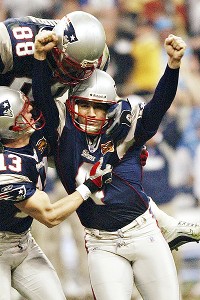
Decembers to Remember: Everyone knows the San Diego Chargers turn it on as the holidays approach, and they are 34-17 in December in the past decade. But the team that owns Christmas month is the New England Patriots, who are 42-7 in December in the same span. Possibly this is because while other NFL teams move to their practice bubbles when the weather turns nasty, the Flying Elvii continue to practice outside. The worst Decembers of the past decade are Detroit (13-37) and Oakland (16-35). Detroit is always indoors at home, Oakland's home offers ideal weather. Both teams fold when it's cold outside. Detroit and Oakland meet next week. Let's hope one of them wins!
Buck-Buck-Brawckkkkkkk: Reaching fourth-and-goal on the Pittsburgh 2 on the first possession of the game, Cleveland kicked a field goal, and TMQ wrote the words "game over" in his notebook. It was Browns 3, Steelers 0 early in the first quarter yet the game was so totally over! Cleveland went on to lose 14-3.
The situation as the contest started was that the Browns, a losing team for many seasons, entered on a 1-10 streak in Pittsburgh, where the Steelers have been a winning team for many seasons. That made the Steelers the champs, and the Browns the chumps, in this situation. You can't dance with the champ -- you have to knock him down. Cleveland had an opportunity to score a touchdown on its first possession or, failing that, to set an aggressive tone while pinning Pittsburgh against its own goal line. Instead, Browns' coach Pat Shurmur used a passive strategy, and now Cleveland is on a 1-11 streak at Pittsburgh. It is an indicator of how irrelevant the Browns have been in recent years that the above is the first time the words "Pat Shurmur" have appeared in TMQ this season.
When Pittsburgh faced fourth-and-goal on the Cleveland 1 in the same contest, the Steelers went for it. They were denied, but so what? This set an aggressive tone, and pinned the Browns against their own goal line. The contest was a perfect test case for TMQ's contention that often it is better for go for it and fail than to launch a mincing fraidy-cat kick. At the goal line, both teams faced the same choice. The team that did the "safe" thing lost and the team that took a risk won, even though the risk failed.
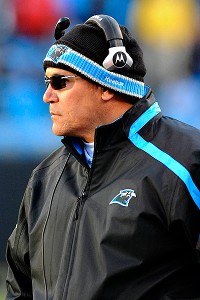
Cheer-Babe Professionalism Watch: Now that the weather has turned cold, cheer-babe professionalism comes into play. Professionalism in this sense means skin or at least skin-tight: this propitiates the football gods. The New England at Washington and Indianapolis at Baltimore games were played 30 miles apart, in the same weather. The Ravens cheerleaders sported bare-midriff outfits, and the Ravens won. The Redskins cheerleaders wore track suits with jackets, and the Redskins lost.
In the Atlanta-at-Carolina contest, Panthers coach Ron Rivera wore a heavy parka and ski cap -- for a kickoff temperature of 43. He violated the TMQ immutable law, Cold Coach = Victory. And yea, verily, it came to pass that the Panthers lost.
More Good News Buried: I said the mainstream media were making it seem as though the country was backtracking on air pollution control, but were not mentioning that smog has been in steady decline for 30 years. Martha Wilton of Los Angeles writes, "The picture is even better than you noted. The Obama administration promulgated regulations that require the average gas mileage of new cars and light trucks to double by 2025. This not only will reduce demand for imported oil -- less gasoline burned means less air pollution." The MPG standards, which passed with little controversy, will do more to reduce smog than the proposed EPA rules that got all the talk radio and newspaper attention.

The new MPG standards are one of government's most important achievements in the past decade. Since the story is positive, you don't read or hear about it in the MSM. Raising the MPG levels of new cars and trucks will make them a little more expensive to purchase, but more than pay back the cost in fuel savings. Americans need to start think about fossil fuels in "life cycle" terms -- not what is cheapest to buy up front but what is cheapest to buy and then operate for a number of years. If you think this way, you'll purchase compact florescent or LED lights; high-efficiency air conditioners and furnaces; high-MPG or hybrid vehicles. If public utility commissions thought this way, they would insist that utilities build combined-cycle coal gasification power plants, not pulverized coal power plants (a 1920s engineering concept). All these cost more up front but cost less to own because they use less fuel in the long run.
Why wait for 2025 when you can purchase a large, comfortable high-MPG vehicle right now? Ford's impressive new Mustang has a 305-horsepower engine yet gets 31 MPG on the highway. Volkswagen's impressive new Passat clean diesel is quite stylish and gets 40 MPG on the highway plus does zero to 60 in a spry 8.6 seconds. I just bought a Honda CRV, a midsize SUV -- built in East Liberty, Ohio -- and got 29 miles per gallon on a trip, with a car that is roomy and comfortable.

Hybrid technology offers high fuel efficiency right now, as does clean diesel. American buyers think of diesel cars are dirty, slow and hard to start. That was true in the 1970s. At a European airport, I rented a Ford clean-diesel model and found it ran smoothly, started on the first twist of the key ("glow plugs" are history in cars) and had plenty of pep. Kicker: I did this 15 years ago! The European Union keeps its petroleum imports down partly by widespread use of clean diesel cars. It's time the United States did the same.
Lend Me a Tight End! Four NFL teams -- Green Bay, Houston, New England and New Orleans -- routinely use multiple tight end sets. Their combined record is 43-9. Why does the rest of the league not notice? P.S.: It's working for Stanford, too.
A Cosmic Thought: Last week astronomers announced the discovery of the closest thing yet to an Earthlike world in another star system. The planet, christened Kepler 22b, orbits a sunlike star, Kepler 22, that is about 600 light-years away -- "nearby" in galactic terms, an unfathomable distance to current technology. At the fastest speed achieved by a spacecraft, reaching Kepler 22b would take about three million years.

The newly discovered planet is significant because it orbits its star in the Goldilocks zone -- not too hot, not too cold -- the distance from a star that makes liquid water possible. Kepler 22b may have surface temperatures similar to Earth's. All other "extrasolar" planets found so far are so close to their stars surface water would boil, or so far away they would be snowballs. Kepler 22b is more than twice the mass of Earth, and nothing is known about its composition. But at last, men and women have looked far into the heavens and glimpsed another world at least somewhat like ours.
In his fine new book "The Life of Super-Earths" -- don't be put off by the odd title -- Harvard astronomer Dimitar Sasselov estimates there could be 100 million habitable planets in our galaxy. He further supposes that while star formation in the universe either has already peaked or will peak "soon" in cosmic terms, the business of forming planets barely has begun. Sasselov estimates that only about 2 percent of the original material of the firmament has been converted (by supernovae) from the light element hydrogen into heavy elements needed for planets. Most of the worlds that will exist haven't even formed yet, he supposes.
It seems only a matter to time until a true Earthlike planet is found beyond the solar system. Then the questions will be: Is its sky blue? Because oxygen is highly reactive, an oxygen-rich blue atmosphere probably could exist only on a world where some living process makes oxygen. The other question will be: On the side of the planet that's in darkness, are there artificial lights?

Perfection Watch: Green Bay has become so efficient on offense it's almost spooky. It took the Packers just five snaps to go 84 yards on one touchdown drive versus Oakland, the defense looking confused by Green Bay's rapid no-huddle pace although every citizen of Wisconsin knew it was coming. Results of the first five Green Bay possessions: touchdown, touchdown, field goal, touchdown, touchdown.
Just as at this juncture last season, the Packers need to get over their allergy to rushing. Leading 31-0, Green Bay reached goal-to-go on the Raiders' 4 and went incompletion, incompletion, interception. In that situation they should have shortened the game by rushing three times and, if foiled, kicking a field goal.
And what was backup quarterback Matt Flynn doing retreating into his own end zone to attempt a pass when Green Bay led 46-7? TMQ has noted before that the Packers keep their starters on the field too long during blowouts. Star receiver Greg Jennings was injured in the third quarter, when Green Bay led by 31 points. Why was he even in the game?
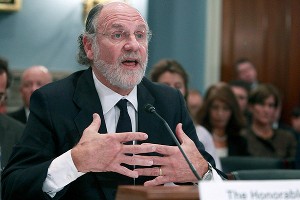
More Reasons to Love CEOs: Last week, former U.S. senator and New Jersey governor Jon Corzine told a congressional committee he had no idea, absolutely no clue, what happened to the $1.2 billion that vanished from the appropriately named MF Global, the brokerage firm Corzine ran until its bankruptcy. Really, the money was here just a minute ago! Nobody would ever dream of stealing $1.2 billion from customer accounts, that couldn't happen!
Though Corzine was both CEO and chairman of MF, he claimed not to have been informed what the company was doing. "I was never informed" is the standard dodge of politicians and CEOs who want the money and perks that come with power and then, caught, claim to have been powerless. It's not yet known how much MF paid Corzine for his 18 months at the helm: the two men he replaced were paid about $6 million in their final year. Corzine, a former CEO of Goldman Sachs, was hired by MF Global for his financial expertise, and now claims he knew nothing, absolutely nothing, about the company's finances.
If only such corporate nonsense were rare. Transocean, the drilling company that owned and operated the Deepwater Horizon rig (BP held a lease) that exploded in the Gulf of Mexico in 2010, killing 11 people and causing the Gulf oil spill, without giggling declared that in 2010 it achieved "the best year in safety performance in our company's history." Transocean CEO Steven Newman was paid $5.8 million for 2010, a lavish reward for a year in which his company had 11 employees killed on the job.
Over at Fannie Mae and Freddie Mac, CEOs Charles Haldeman Jr. and Michael Williams received $17 million in bonuses for 2009 and 2010 -- years in which the companies lost $153 billion, passing the losses along to the taxpayer. A House bill may suspend the bonuses. Fannie's and Freddie's books were gimmicked to make it appear the CEOs brought in lots of new capital, thus justifying lavish pay.
The new capital actually was a federal bailout, which the two CEOs did nothing to "earn." If the Fannie and Freddie CEOs had reached into the till for $17 million, they'd now be in jail. Because they laundered the money by awarding it to themselves as bonuses, so far they've kept the cash.

One reason business executives CEOs get away with big rewards for doing a bad job is that the money is called "compensation," as if CEOs were philanthropists performing some exalted service to humanity. Fortune 500 firms call what they give workers "pay," and call what they give CEOs "compensation." Politicians and boards of directors play along, using the lofty word "compensation," as if the CEO had honored the firm by boarding the private jet. The media play along too. This New York Times article on the federal report blasting subsidized CEO bonuses used the word "compensation" 12 times.
Why do CEO pay themselves outrageous amounts for poor performance? Usually the answer is: Because they can. Public companies need boards of directors to protect shareholders, rather than rubber-stamping management greed. Subsidized companies such as Fannie, Freddie and General Motors should have their top management pay voted on by Congress, to force the people's representatives to go on the record about giveaways. Journalists and professors of economics should stop using the silly euphemism "compensation" and start referring to "CEO pay."
Disclaimer of the Week: Reader Tim Cors of St. Louis reports, "My wife and I were excited to get our new Calphalon cookware, one of the extravagant gifts on our registry. After being sold on its features, in particular the advertised 'dishwasher safe' care and lifetime warranty, you can imagine our surprise when we dug into the box and read the owner's manual -- only to find that dishwasher use will void the warranty."
Untouched Touchdown Run of the Week: First-and-goal from the Kansas City 1, Jersey/B quarterback Mark Sanchez executed the naked bootleg so convincingly that he not only jogged into the end zone untouched -- not a one of the 11 Chiefs defenders realized he had the ball.
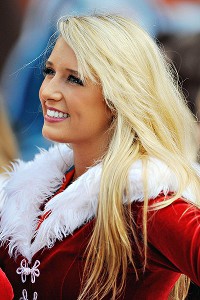
TMQ Readers Know Too Much: Last week I noted that if the Packers beat Oakland, they would advance to a 19-0 streak; New England in the 2007 season was stopped at 18-0. The Packers' 2011 streak began in 2010. Dan Magazu of Somerville, Mass., writes, "If you're going to count wins from a previous season, the Patriots went 21-0 from 2003 to 2004, so the Pack still has a few wins to go to reach uncharted territory."
Unhappy Hour in Hell's Sports Bar: At Unhappy Hour in Hell's sports bar, the holiday decorations were out, and eggnog was free. But the eggnog was made from raw ostrich eggs. Patrons in Hell's sports bar did not see any of the Denver Broncos' hard-to-believe comeback. But patrons did see, over and over again, winless Indianapolis, trailing Baltimore by 17-0, kicking a field goal on fourth-and-goal. Then trailing 17-3, punting on fourth-and-1. They saw, over and over again, 2-10 Minnesota, trailing 31-14 with 20 seconds remaining in the first half, kneeling to kill the clock from midfield.
'Tis Better to Have Rushed and Lost Than Never to Have Rushed at All: Arizona leading San Francisco 21-19 with 2:14 remaining in the fourth quarter, the Squared Sevens, one of the league's best rushing teams, faced third-and-1 near midfield. San Francisco went incompletion, incompletion, game over. On the day, the Forty Niners averaged 4.3 yards per rush and 3.4 yards per pass attempt. Why, with the game on the line and just one yard to gain, not rush?
Detroit leading 34-28, Minnesota had the ball on the Lions' 1 yard line with 9 seconds remaining, out of timeouts. Backup quarterback Joe Webb executed a zany rollout play that ended up losing 42 yards as the clock expired. Detroit's DeAndre Levy should have been called for facemasking Webb, which would have given the Vikings another try. The lack of a facemasking call on a game-deciding down was the biggest officiating blunder in the NFL this season.
But why were the Vikings trying to execute a zany rollout in the first place? Webb was already all the way back to the 12 when facemasked. On the day, Minnesota rushed for 269 yards. Detroit had two defensive linemen on the field at the snap. Why sprint backward instead of a little misdirection, then a power rush?

Perhaps Wisconsin Residents Would Like to Purchase Some Greek Bonds: The Packers, the NFL's sole publicly owned team, last week sold $47 million worth of new shares, with the capital to be used for stadium renovation. The shares are essentially worthless to the holder -- they confer no dividends, can't be resold and don't help you with the 93,000-person waiting list for season tickets. They are purchased mainly for novelty reasons, as something to frame and hang on the wall. Basically the shares represent a gift from the citizens of Wisconsin to the Packers. And the price is not tax deductible although the Packers are, absurdly, on paper a nonprofit entity.
Adventures in Officiating: What happened in the second quarter at Arizona? First San Francisco, facing third-and-18 on the Cardinals 43, threw an 11-yard pass, setting up fourth-and-7. Arizona challenged, but the replay equipment wasn't working, voiding the challenge. On fourth-and-7, San Francisco ran a fake field goal attempt, converting for a first down. Then officials said the field goal fake was void because the replay equipment had come back on, and now the Arizona challenge was being entertained. Then officials said the Arizona challenge was void and it was fourth-and-7 again. Then San Francisco missed a field goal, and went on to lose by two points. TMQ watched the replay three times and still does not know what happened.
At Washington, Tom Brady scrambled, ran up the middle then started a hook-slide; London Fletcher hit Brady before he was down. Fletcher was called for unnecessary roughness, though Brady was not down when the hit happened. This gave the Flying Elvii first-and-goal on the Skins' 10. Referee Jeff Triplette announced the penalty was for "a forearm to the head." There was no forearm blow; Fletcher hit Brady square in the chest, exactly the clean contact the league wants. Just two plays later, Brady scrambled again. This time the Washington defenders pulled up -- and Brady did not hook-slide. If a quarterback can't be hit simply because he might slide, how are defenders supposed to play?
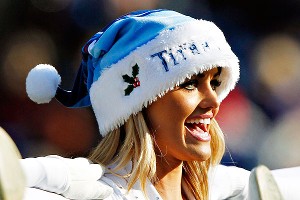
Bolts Sigh With Relief -- It's Finally December: Philip Rivers, who leads the NFL in turnovers with 22, nevertheless is 24-2 on his career from Dec. 1 on. The Bills, hot early in the season, now have not won in the United States since early October. In the Bills-at-Bolts contest, Harvard's Ryan Fitzpatrick had a quarterback rating of 31. If every pass a quarterback attempts falls incomplete, his NFL rating is 39.6. When Buffalo was hot early, Bills management rewarded Fitzpatrick with a lucrative contract extension. Before the new contract, Fitzpatrick had 12 touchdown passes versus six turnovers, and the team was 4-2. Since the new contract, he had eight touchdown passes versus 12 turnovers, and the team is 1-6. How long till the Bills are looking to unload Fitzpatrick? Perhaps February.
Short-Yardage Follies: TMQ law of short-yardage holds: Do a Little Dance If You Want to Gain That Yard. Yet NFL teams continue to run simplistic dive plays on third-and-1 and fourth-and-1, rather than use misdirection. Against Philadelphia, the Dolphins were stuffed on a straight-ahead no misdirection third-and-1. Houston, normally clever about play design, appeared finished when it was stuffed on a simplistic third-and-1 rush, then sacked on fourth-and-2. New England, normally clever about play design, was stuffed on a simplistic straight-ahead try on third-and-1. The Giants lost yardage on a simplistic straight-ahead try on third-and-2. The Titans were stuffed with a simplistic play on third-and-1. A man in motion, a lineman pulling away from the point of attack -- do a little dance if you want to gain that yard. Here is a soundtrack for short-yardage plays.
Obscure College Score of the Week: Mount Union 28, Wesley 21 (Division III semifinal). Located in Dover, Del., Wesley College offers a major in "drama and theater." They're different?
Bonus College Score: Wisconsin Whitewater 20, St. Thomas 0 (Division III semifinal). Located in St. Paul, Minn., the University of St. Thomas lists 45 people on its Board of Trustees. Perhaps they meet at the basketball arena!
These two games set up yet another rematch of Mount Union versus Wisconsin Whitewater in the Amos Alonzo Stagg Bowl. These two schools have, between them, won eight of the past 10 Division III football titles.
Next Week: Weasels object to being compared to Rich Rodriguez and Kevin Sumlin.
 |
| • Philbrick: Page 2's Greatest Hits, 2000-2012 |
| • Caple: Fond memories of a road warrior |
| • Snibbe: An illustrated history of Page 2 |
| Philbrick, Gallo: Farewell podcast |
- Author of "The King of Sports"
- Former Fulbright distinguished fellow
- Contributing editor to "The Atlantic"
ALSO SEE
- Easterbrook: Decoding the Packers' success
- Easterbrook: Root, root for Denver Broncos High!
- Easterbrook: Go to games to appreciate football
- Easterbrook: NFL teams lack short-yardage creativity
- Easterbrook: Defenses have slowed early offensive explosion
- Easterbrook: Tim Tebow didn't earn victory alone
- Easterbrook: The tight end is the key to success
- Easterbrook: Does football hurt college chances?
- Easterbrook: NFL Comebacks are earned
- Easterbrook: Historic rise by Buffalo, Detroit
- Easterbrook: What's to blame for gaudy passing stats?
- Easterbrook: Door closing on NFL's Narnia?
- Easterbrook: The bigger, stronger player
- Easterbrook: Time to rein in football practice
- Easterbrook: Losing cheap trounces winning expensive
- Easterbrook: NFL players can live by rules
ESPN TOP HEADLINES
RECENT ACTIVITY
-
TOOLS
- Contact Us
- Corrections
- Daily Line
- RSS
